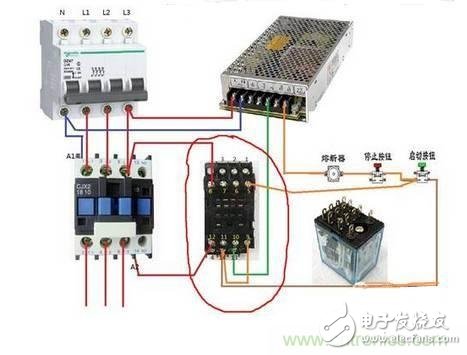Intermediate relay: used in relay protection and automatic control systems to increase the number and capacity of contacts. It is used to pass intermediate signals in the control circuit.
The structure and principle of the intermediate relay are basically the same as those of the AC contactor. The main difference with the contactor is:
The main contacts of the contactor can pass large currents, while the contacts of the intermediate relay can only pass small currents.
Therefore, it can only be used in control circuits. It generally has no main contacts because the overload capability is relatively small. So it uses all the auxiliary contacts, the number is more.
The new national standard defines the intermediate relay as K, and the old national standard is KA. It is usually powered by a DC power supply. A few use AC power.

The role of the intermediate relay
The general circuit is often divided into two parts: the main circuit and the control circuit. The relay is mainly used for the control circuit. The contactor is mainly used for the main circuit. The relay can realize the function of controlling one or several signals with one control signal to complete the start and stop. Control, linkage and other control, the main control object is the contactor; the contacts of the contactor are relatively large, bearing capacity is strong, through it to achieve the control of weak electricity to strong electricity, the control object is electrical appliances.
Intermediate relay component
The intermediate relay is a relay. Its principle is the same as that of the AC contactor. It consists of a fixed iron core, a moving iron core, a spring, a moving contact, a static contact, a coil, a terminal block and a casing.
Intermediate relay working principle
When the coil is energized, the moving iron core moves under the action of electromagnetic force, and the moving contact is actuated to make the normally closed contact separate, and the normally open contact is closed; when the coil is powered off, the moving iron core drives the moving contact under the action of the spring. Reset, the working principle of the relay is to make a certain input quantity (such as voltage, current, temperature, speed, pressure, etc.) to move to change the working state of the control circuit to achieve the established control or protection. purpose. In the process, the intermediate relay mainly plays the role of transmitting signals.
What is the difference between an intermediate relay and an AC contactor?
The intermediate relay is a relay. Its principle is the same as that of the AC contactor. It consists of a fixed iron core, a moving iron core, a spring, a moving contact, a static contact, a coil, a terminal block and an outer casing. When the coil is energized, the moving iron core moves under the action of electromagnetic force, and the moving contact is actuated to make the normally closed contact separate, and the normally open contact is closed; when the coil is powered off, the moving iron core drives the moving contact under the action of the spring. Reset.
In industrial control lines and current home appliance control lines, there are often intermediate relays. For different control lines, the role of intermediate relays is different. The functions of the intermediate relays are common in the following ways:
1, instead of small contactors
The contacts of the intermediate relay have a certain load capacity. When the load capacity is small, it can be used to replace the use of small contactors, such as electric shutters and some small appliances. This has the advantage that it can not only serve the purpose of control, but also save space and make the control part of the appliance more delicate.
2, increase the number of contacts
This is the most common use of intermediate relays. For example, in a circuit control system, when a contactor of a contactor needs to control multiple contactors or other components, an intermediate relay is added to the line.
3, increase the contact capacity
Although the contact capacity of the intermediate relay is not very large, it also has a certain load capacity, and the current required for its driving is small, so the intermediate relay can be used to expand the contact capacity. For example, it is generally not possible to directly use the output of the inductive switch or the triode to control the electrical components with relatively large loads. Instead, an intermediate relay is used in the control line, and other loads are controlled by the intermediate relay to achieve the purpose of expanding the control capacity.
4, conversion contact type
In industrial control lines, it is often the case that the control requires the use of a normally closed contact of the contactor for control purposes, but the normally closed contact of the contactor itself has been used up and the control task cannot be completed. At this time, an intermediate relay can be connected in parallel with the original contactor coil, and the normally closed contact of the intermediate relay can be used to control the corresponding components, and the type of the contact is switched to achieve the required control purpose.
In some control lines, the switching of some electrical components often uses an intermediate relay, which is controlled by the opening and closing of its contacts. For example, the automatic degaussing circuit commonly used in color TVs or displays, the triode controls the on and off of the intermediate relays, thereby achieving control degaussing. The function of the coil on and off.
6, eliminate interference in the circuit
In industrial control or computer control lines, although there are various interference suppression measures, the interference phenomenon is more or less present.
Single Arm Signal Pole,Camera Light Pole,Single-Arm Traffic Steel Pole,Traffic Signal Light Tube Pole
Jiangsu Baojuhe Science and Technology Co.,Ltd. , https://www.galvanizedsteelpole.com